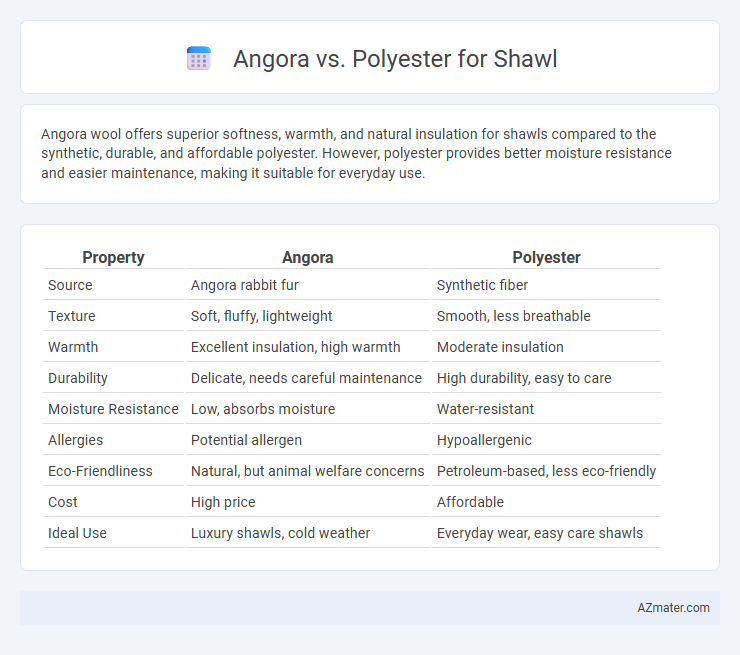Angora wool offers superior softness, warmth, and natural insulation for shawls compared to the synthetic, durable, and affordable polyester. However, polyester provides better moisture resistance and easier maintenance, making it suitable for everyday use.
Table of Comparison
| Property | Angora | Polyester |
|---|---|---|
| Source | Angora rabbit fur | Synthetic fiber |
| Texture | Soft, fluffy, lightweight | Smooth, less breathable |
| Warmth | Excellent insulation, high warmth | Moderate insulation |
| Durability | Delicate, needs careful maintenance | High durability, easy to care |
| Moisture Resistance | Low, absorbs moisture | Water-resistant |
| Allergies | Potential allergen | Hypoallergenic |
| Eco-Friendliness | Natural, but animal welfare concerns | Petroleum-based, less eco-friendly |
| Cost | High price | Affordable |
| Ideal Use | Luxury shawls, cold weather | Everyday wear, easy care shawls |
Understanding Angora and Polyester Fibers
Angora fibers, derived from Angora rabbits, are renowned for their exceptional softness, lightweight warmth, and natural insulation, making them a luxurious choice for shawls. In contrast, polyester fibers, a synthetic material, offer durability, wrinkle resistance, and affordability but lack the breathability and natural warmth of Angora. Understanding the source and properties of these fibers helps in selecting shawls that balance comfort, maintenance, and cost effectively.
Key Differences Between Angora and Polyester
Angora shawls are made from natural fibers derived from Angora rabbits, providing exceptional softness, warmth, and breathability compared to synthetic polyester shawls, which prioritize durability and wrinkle resistance. Angora offers superior moisture-wicking properties and a luxurious texture, while polyester excels in affordability, easy care, and resistance to shrinking or stretching. The key differences include Angora's natural insulation and environmental impact versus polyester's synthetic production and enhanced longevity.
Softness and Comfort Comparison
Angora fibers, derived from Angora rabbits, are renowned for their exceptional softness, lightweight warmth, and luxurious feel, making shawls incredibly comfortable and gentle against the skin. Polyester, a synthetic material, lacks the natural softness of Angora and can feel less breathable, often resulting in reduced comfort during extended wear. The natural moisture-wicking and thermal properties of Angora contribute to superior comfort compared to the less breathable, sometimes coarse texture of polyester shawls.
Warmth and Insulation Properties
Angora fibers provide exceptional warmth and insulation due to their fine, hollow structure that traps air effectively, making Angora shawls significantly warmer than those made from polyester. Polyester, while durable and moisture-resistant, lacks the natural breathability and heat retention properties of Angora, resulting in lower insulation performance. For cold weather, Angora shawls offer superior thermal regulation and softness compared to synthetic polyester options.
Durability and Longevity of Each Material
Angora wool offers exceptional durability due to its natural elasticity and strong fibers, making it resistant to wear and tear over time. Polyester fibers provide high longevity through synthetic resilience, maintaining shape and color even after frequent washing. While Angora requires delicate care to preserve its softness, polyester delivers superior durability for long-term use in shawls.
Breathability and Moisture-Wicking Abilities
Angora fibers, known for their superior breathability, allow air circulation that helps regulate body temperature, making shawls comfortable to wear in varying climates. Polyester, a synthetic material, often lacks natural breathability but excels in moisture-wicking by quickly drawing sweat away from the skin, keeping the wearer dry during physical activities. When choosing between angora and polyester for shawls, angora offers a more breathable option ideal for moderate moisture control, while polyester provides enhanced moisture management suited for high-intensity use.
Maintenance and Care Requirements
Angora shawls require delicate maintenance, including hand washing with mild detergent and air drying to preserve their softness and prevent fiber damage. Polyester shawls offer easy care as they are machine washable and wrinkle-resistant, making them more durable and low maintenance. Proper storage in a breathable bag helps maintain Angora's natural fibers, while Polyester's synthetic composition resists moths and mildew.
Price and Value Considerations
Angora shawls typically command a higher price due to the luxurious softness and natural insulation provided by Angora fibers, derived from Angora rabbits, which also makes them more delicate and requires careful maintenance. Polyester shawls are significantly more affordable, offering durability and easy care but lacking the breathability and premium feel of natural fibers. When weighing price against value, Angora shawls represent a worthwhile investment for those seeking warmth and luxury, while polyester shawls deliver practical value through cost-effectiveness and long-lasting wear.
Sustainability and Environmental Impact
Angora wool, derived from Angora rabbits, offers a biodegradable and renewable fiber option with lower carbon emissions compared to synthetic polyester, which relies on petroleum-based resources and contributes significantly to microplastic pollution. The production of Angora wool supports sustainable farming practices when ethically sourced, reducing environmental degradation and chemical use. Polyester shawls, although durable and cost-effective, have a larger ecological footprint due to non-renewable resource extraction and challenges in recycling and biodegradability.
Choosing the Best Material for Your Shawl
Angora offers exceptional softness and warmth, making it ideal for luxurious shawls with a lightweight feel, while polyester provides durability, affordability, and easy maintenance. When choosing the best material for your shawl, consider angora for natural insulation and breathability, whereas polyester excels in wrinkle resistance and color retention. Balancing comfort and practicality depends on your preference for natural fibers versus synthetic longevity in shawl fabric.

Infographic: Angora vs Polyester for Shawl
 azmater.com
azmater.com